HI6028 Taxation Assignment: Partnership Tax Return, FBT, 2017 & 2018
VerifiedAdded on 2023/04/23
|7
|1631
|369
Homework Assignment
AI Summary
This document presents a comprehensive solution to a taxation assignment for the HI6028 course. The assignment focuses on the computation of income tax for Brekkie and Lunch and OZ Bottle Shop, considering sales receipts, cost of sales, depreciation, and various expenses. It includes detailed working notes for calculations, application of the Income Tax Assessment Act 1997, and analysis of deductible expenses. Furthermore, the document addresses fringe benefit tax (FBT) implications, covering Type 2 fringe benefits, with calculations for school fees and residential accommodation provided to an employee, referencing the Fringe Benefit Tax Act 1986 and related ATO guidelines. It emphasizes compliance with FBT regulations, record-keeping, and payment obligations, and provides relevant text from tax legislation and ATO resources to support the calculations and conclusions.
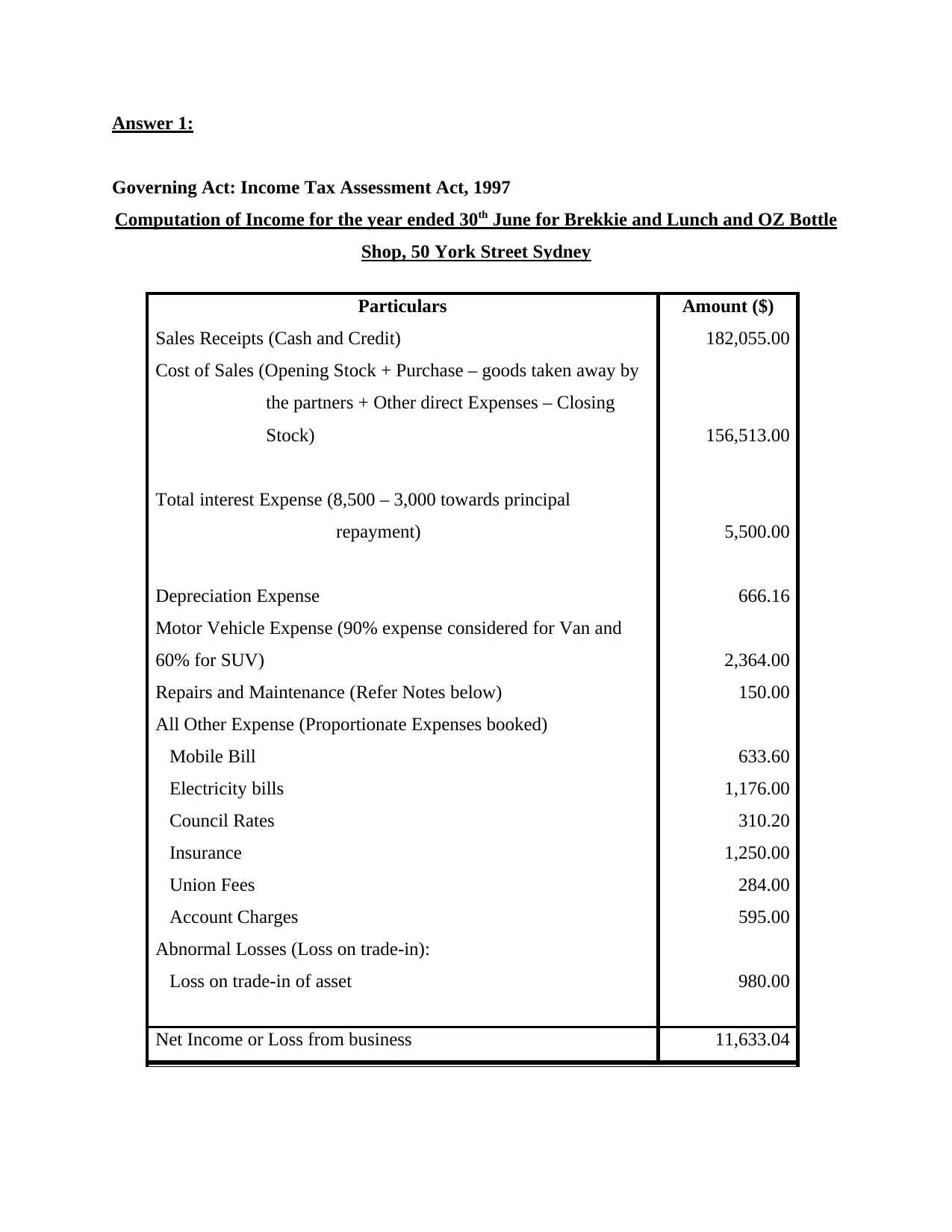
Answer 1:
Governing Act: Income Tax Assessment Act, 1997
Computation of Income for the year ended 30th June for Brekkie and Lunch and OZ Bottle
Shop, 50 York Street Sydney
Particulars
Sales Receipts (Cash and Credit)
Amount ($)
182,055.00
Cost of Sales (Opening Stock + Purchase – goods taken away by
the partners + Other direct Expenses – Closing
Stock) 156,513.00
Total interest Expense (8,500 – 3,000 towards principal
repayment) 5,500.00
Depreciation Expense 666.16
Motor Vehicle Expense (90% expense considered for Van and
60% for SUV) 2,364.00
Repairs and Maintenance (Refer Notes below) 150.00
All Other Expense (Proportionate Expenses booked)
Mobile Bill 633.60
Electricity bills 1,176.00
Council Rates 310.20
Insurance 1,250.00
Union Fees 284.00
Account Charges 595.00
Abnormal Losses (Loss on trade-in):
Loss on trade-in of asset 980.00
Net Income or Loss from business 11,633.04
Governing Act: Income Tax Assessment Act, 1997
Computation of Income for the year ended 30th June for Brekkie and Lunch and OZ Bottle
Shop, 50 York Street Sydney
Particulars
Sales Receipts (Cash and Credit)
Amount ($)
182,055.00
Cost of Sales (Opening Stock + Purchase – goods taken away by
the partners + Other direct Expenses – Closing
Stock) 156,513.00
Total interest Expense (8,500 – 3,000 towards principal
repayment) 5,500.00
Depreciation Expense 666.16
Motor Vehicle Expense (90% expense considered for Van and
60% for SUV) 2,364.00
Repairs and Maintenance (Refer Notes below) 150.00
All Other Expense (Proportionate Expenses booked)
Mobile Bill 633.60
Electricity bills 1,176.00
Council Rates 310.20
Insurance 1,250.00
Union Fees 284.00
Account Charges 595.00
Abnormal Losses (Loss on trade-in):
Loss on trade-in of asset 980.00
Net Income or Loss from business 11,633.04
Paraphrase This Document
Need a fresh take? Get an instant paraphrase of this document with our AI Paraphraser
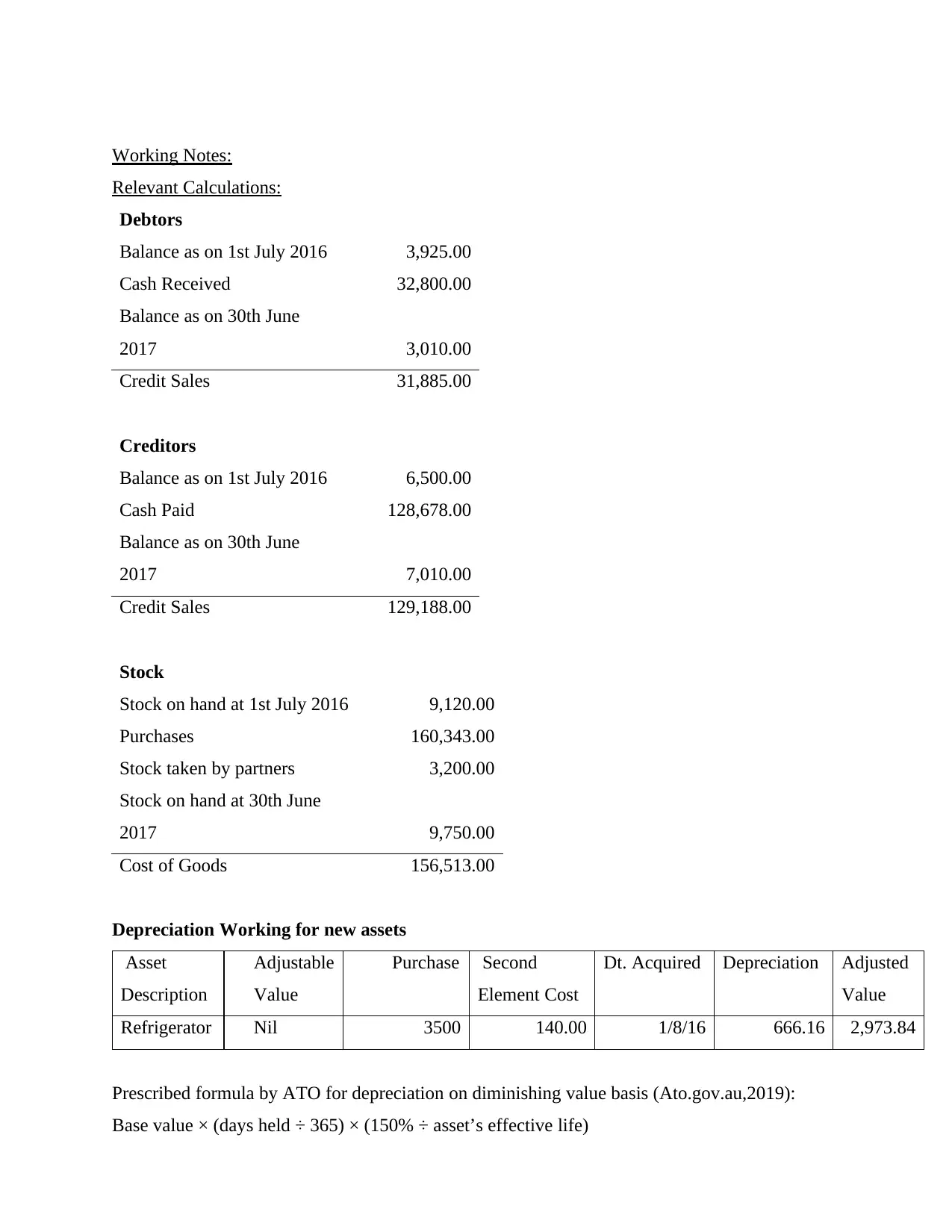
Working Notes:
Relevant Calculations:
Debtors
Balance as on 1st July 2016 3,925.00
Cash Received 32,800.00
Balance as on 30th June
2017 3,010.00
Credit Sales 31,885.00
Creditors
Balance as on 1st July 2016 6,500.00
Cash Paid 128,678.00
Balance as on 30th June
2017 7,010.00
Credit Sales 129,188.00
Stock
Stock on hand at 1st July 2016 9,120.00
Purchases 160,343.00
Stock taken by partners 3,200.00
Stock on hand at 30th June
2017 9,750.00
Cost of Goods 156,513.00
Depreciation Working for new assets
Asset
Description
Adjustable
Value
Purchase Second
Element Cost
Dt. Acquired Depreciation Adjusted
Value
Refrigerator Nil 3500 140.00 1/8/16 666.16 2,973.84
Prescribed formula by ATO for depreciation on diminishing value basis (Ato.gov.au,2019):
Base value × (days held ÷ 365) × (150% ÷ asset’s effective life)
Relevant Calculations:
Debtors
Balance as on 1st July 2016 3,925.00
Cash Received 32,800.00
Balance as on 30th June
2017 3,010.00
Credit Sales 31,885.00
Creditors
Balance as on 1st July 2016 6,500.00
Cash Paid 128,678.00
Balance as on 30th June
2017 7,010.00
Credit Sales 129,188.00
Stock
Stock on hand at 1st July 2016 9,120.00
Purchases 160,343.00
Stock taken by partners 3,200.00
Stock on hand at 30th June
2017 9,750.00
Cost of Goods 156,513.00
Depreciation Working for new assets
Asset
Description
Adjustable
Value
Purchase Second
Element Cost
Dt. Acquired Depreciation Adjusted
Value
Refrigerator Nil 3500 140.00 1/8/16 666.16 2,973.84
Prescribed formula by ATO for depreciation on diminishing value basis (Ato.gov.au,2019):
Base value × (days held ÷ 365) × (150% ÷ asset’s effective life)
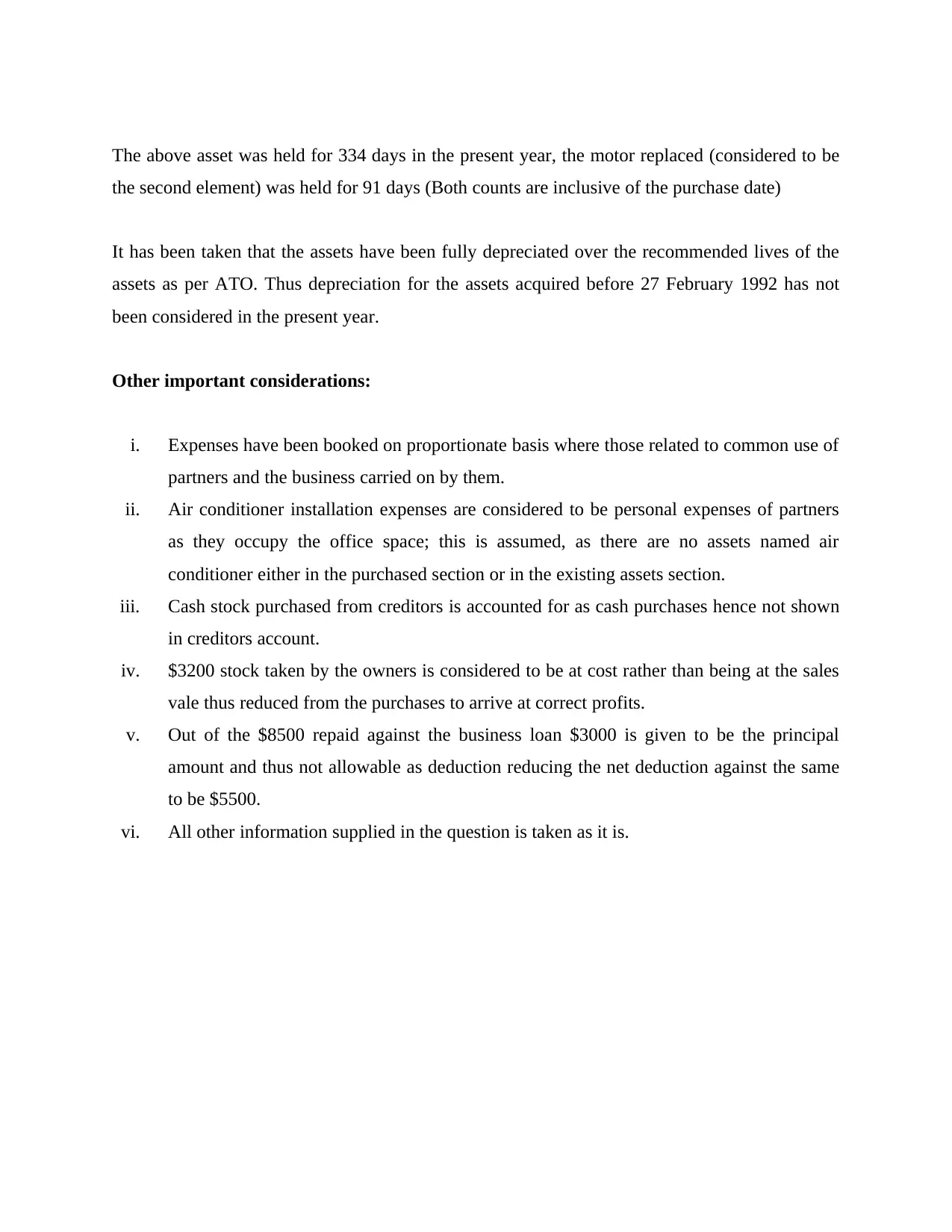
The above asset was held for 334 days in the present year, the motor replaced (considered to be
the second element) was held for 91 days (Both counts are inclusive of the purchase date)
It has been taken that the assets have been fully depreciated over the recommended lives of the
assets as per ATO. Thus depreciation for the assets acquired before 27 February 1992 has not
been considered in the present year.
Other important considerations:
i. Expenses have been booked on proportionate basis where those related to common use of
partners and the business carried on by them.
ii. Air conditioner installation expenses are considered to be personal expenses of partners
as they occupy the office space; this is assumed, as there are no assets named air
conditioner either in the purchased section or in the existing assets section.
iii. Cash stock purchased from creditors is accounted for as cash purchases hence not shown
in creditors account.
iv. $3200 stock taken by the owners is considered to be at cost rather than being at the sales
vale thus reduced from the purchases to arrive at correct profits.
v. Out of the $8500 repaid against the business loan $3000 is given to be the principal
amount and thus not allowable as deduction reducing the net deduction against the same
to be $5500.
vi. All other information supplied in the question is taken as it is.
the second element) was held for 91 days (Both counts are inclusive of the purchase date)
It has been taken that the assets have been fully depreciated over the recommended lives of the
assets as per ATO. Thus depreciation for the assets acquired before 27 February 1992 has not
been considered in the present year.
Other important considerations:
i. Expenses have been booked on proportionate basis where those related to common use of
partners and the business carried on by them.
ii. Air conditioner installation expenses are considered to be personal expenses of partners
as they occupy the office space; this is assumed, as there are no assets named air
conditioner either in the purchased section or in the existing assets section.
iii. Cash stock purchased from creditors is accounted for as cash purchases hence not shown
in creditors account.
iv. $3200 stock taken by the owners is considered to be at cost rather than being at the sales
vale thus reduced from the purchases to arrive at correct profits.
v. Out of the $8500 repaid against the business loan $3000 is given to be the principal
amount and thus not allowable as deduction reducing the net deduction against the same
to be $5500.
vi. All other information supplied in the question is taken as it is.
⊘ This is a preview!⊘
Do you want full access?
Subscribe today to unlock all pages.

Trusted by 1+ million students worldwide
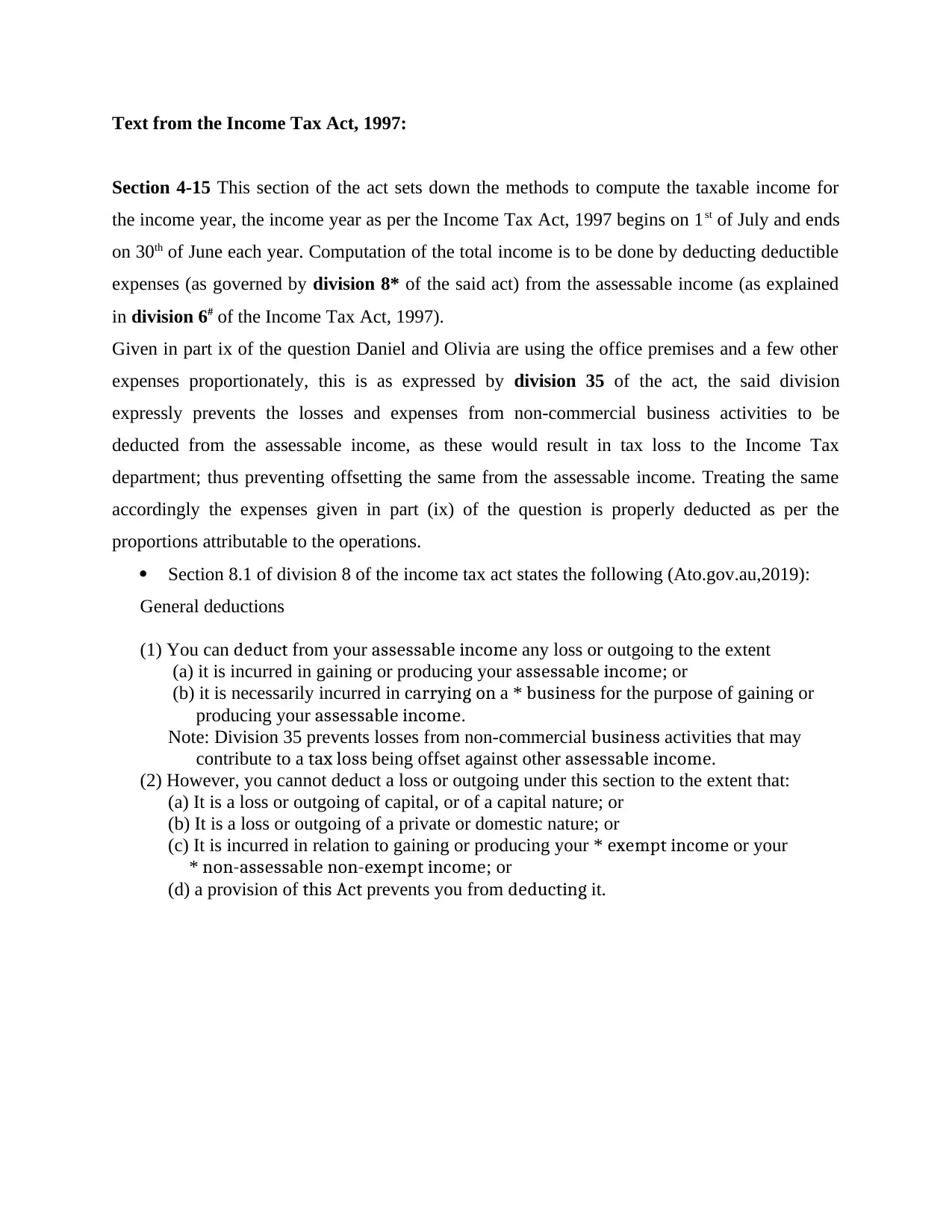
Text from the Income Tax Act, 1997:
Section 4-15 This section of the act sets down the methods to compute the taxable income for
the income year, the income year as per the Income Tax Act, 1997 begins on 1st of July and ends
on 30th of June each year. Computation of the total income is to be done by deducting deductible
expenses (as governed by division 8* of the said act) from the assessable income (as explained
in division 6# of the Income Tax Act, 1997).
Given in part ix of the question Daniel and Olivia are using the office premises and a few other
expenses proportionately, this is as expressed by division 35 of the act, the said division
expressly prevents the losses and expenses from non-commercial business activities to be
deducted from the assessable income, as these would result in tax loss to the Income Tax
department; thus preventing offsetting the same from the assessable income. Treating the same
accordingly the expenses given in part (ix) of the question is properly deducted as per the
proportions attributable to the operations.
Section 8.1 of division 8 of the income tax act states the following (Ato.gov.au,2019):
General deductions
(1) You can deduct from your assessable income any loss or outgoing to the extent
(a) it is incurred in gaining or producing your assessable income; or
(b) it is necessarily incurred in carrying on a * business for the purpose of gaining or
producing your assessable income.
Note: Division 35 prevents losses from non-commercial business activities that may
contribute to a tax loss being offset against other assessable income.
(2) However, you cannot deduct a loss or outgoing under this section to the extent that:
(a) It is a loss or outgoing of capital, or of a capital nature; or
(b) It is a loss or outgoing of a private or domestic nature; or
(c) It is incurred in relation to gaining or producing your * exempt income or your
* non-assessable non-exempt income; or
(d) a provision of this Act prevents you from deducting it.
Section 4-15 This section of the act sets down the methods to compute the taxable income for
the income year, the income year as per the Income Tax Act, 1997 begins on 1st of July and ends
on 30th of June each year. Computation of the total income is to be done by deducting deductible
expenses (as governed by division 8* of the said act) from the assessable income (as explained
in division 6# of the Income Tax Act, 1997).
Given in part ix of the question Daniel and Olivia are using the office premises and a few other
expenses proportionately, this is as expressed by division 35 of the act, the said division
expressly prevents the losses and expenses from non-commercial business activities to be
deducted from the assessable income, as these would result in tax loss to the Income Tax
department; thus preventing offsetting the same from the assessable income. Treating the same
accordingly the expenses given in part (ix) of the question is properly deducted as per the
proportions attributable to the operations.
Section 8.1 of division 8 of the income tax act states the following (Ato.gov.au,2019):
General deductions
(1) You can deduct from your assessable income any loss or outgoing to the extent
(a) it is incurred in gaining or producing your assessable income; or
(b) it is necessarily incurred in carrying on a * business for the purpose of gaining or
producing your assessable income.
Note: Division 35 prevents losses from non-commercial business activities that may
contribute to a tax loss being offset against other assessable income.
(2) However, you cannot deduct a loss or outgoing under this section to the extent that:
(a) It is a loss or outgoing of capital, or of a capital nature; or
(b) It is a loss or outgoing of a private or domestic nature; or
(c) It is incurred in relation to gaining or producing your * exempt income or your
* non-assessable non-exempt income; or
(d) a provision of this Act prevents you from deducting it.
Paraphrase This Document
Need a fresh take? Get an instant paraphrase of this document with our AI Paraphraser
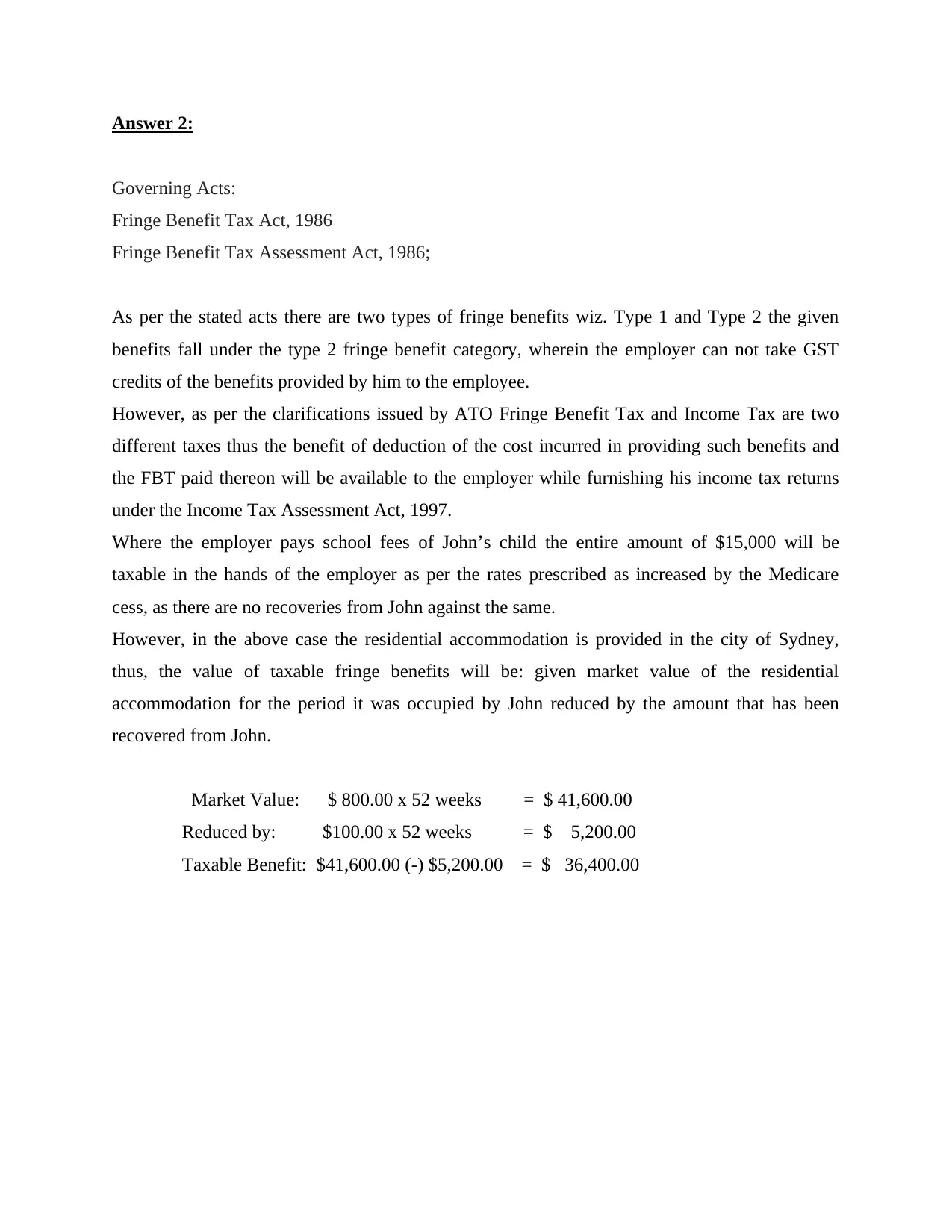
Answer 2:
Governing Acts:
Fringe Benefit Tax Act, 1986
Fringe Benefit Tax Assessment Act, 1986;
As per the stated acts there are two types of fringe benefits wiz. Type 1 and Type 2 the given
benefits fall under the type 2 fringe benefit category, wherein the employer can not take GST
credits of the benefits provided by him to the employee.
However, as per the clarifications issued by ATO Fringe Benefit Tax and Income Tax are two
different taxes thus the benefit of deduction of the cost incurred in providing such benefits and
the FBT paid thereon will be available to the employer while furnishing his income tax returns
under the Income Tax Assessment Act, 1997.
Where the employer pays school fees of John’s child the entire amount of $15,000 will be
taxable in the hands of the employer as per the rates prescribed as increased by the Medicare
cess, as there are no recoveries from John against the same.
However, in the above case the residential accommodation is provided in the city of Sydney,
thus, the value of taxable fringe benefits will be: given market value of the residential
accommodation for the period it was occupied by John reduced by the amount that has been
recovered from John.
Market Value: $ 800.00 x 52 weeks = $ 41,600.00
Reduced by: $100.00 x 52 weeks = $ 5,200.00
Taxable Benefit: $41,600.00 (-) $5,200.00 = $ 36,400.00
Governing Acts:
Fringe Benefit Tax Act, 1986
Fringe Benefit Tax Assessment Act, 1986;
As per the stated acts there are two types of fringe benefits wiz. Type 1 and Type 2 the given
benefits fall under the type 2 fringe benefit category, wherein the employer can not take GST
credits of the benefits provided by him to the employee.
However, as per the clarifications issued by ATO Fringe Benefit Tax and Income Tax are two
different taxes thus the benefit of deduction of the cost incurred in providing such benefits and
the FBT paid thereon will be available to the employer while furnishing his income tax returns
under the Income Tax Assessment Act, 1997.
Where the employer pays school fees of John’s child the entire amount of $15,000 will be
taxable in the hands of the employer as per the rates prescribed as increased by the Medicare
cess, as there are no recoveries from John against the same.
However, in the above case the residential accommodation is provided in the city of Sydney,
thus, the value of taxable fringe benefits will be: given market value of the residential
accommodation for the period it was occupied by John reduced by the amount that has been
recovered from John.
Market Value: $ 800.00 x 52 weeks = $ 41,600.00
Reduced by: $100.00 x 52 weeks = $ 5,200.00
Taxable Benefit: $41,600.00 (-) $5,200.00 = $ 36,400.00
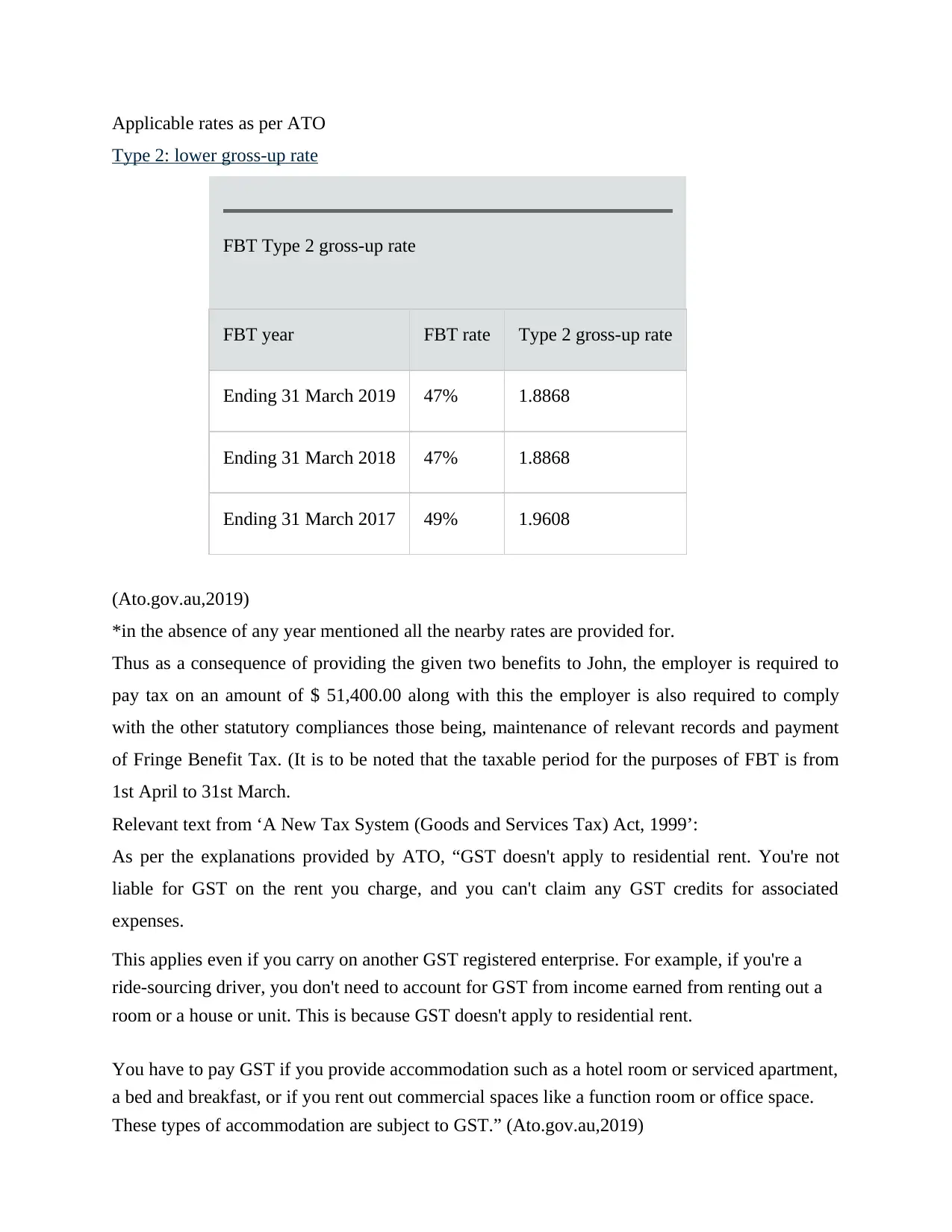
Applicable rates as per ATO
Type 2: lower gross-up rate
FBT Type 2 gross-up rate
FBT year FBT rate Type 2 gross-up rate
Ending 31 March 2019 47% 1.8868
Ending 31 March 2018 47% 1.8868
Ending 31 March 2017 49% 1.9608
(Ato.gov.au,2019)
*in the absence of any year mentioned all the nearby rates are provided for.
Thus as a consequence of providing the given two benefits to John, the employer is required to
pay tax on an amount of $ 51,400.00 along with this the employer is also required to comply
with the other statutory compliances those being, maintenance of relevant records and payment
of Fringe Benefit Tax. (It is to be noted that the taxable period for the purposes of FBT is from
1st April to 31st March.
Relevant text from ‘A New Tax System (Goods and Services Tax) Act, 1999’:
As per the explanations provided by ATO, “GST doesn't apply to residential rent. You're not
liable for GST on the rent you charge, and you can't claim any GST credits for associated
expenses.
This applies even if you carry on another GST registered enterprise. For example, if you're a
ride-sourcing driver, you don't need to account for GST from income earned from renting out a
room or a house or unit. This is because GST doesn't apply to residential rent.
You have to pay GST if you provide accommodation such as a hotel room or serviced apartment,
a bed and breakfast, or if you rent out commercial spaces like a function room or office space.
These types of accommodation are subject to GST.” (Ato.gov.au,2019)
Type 2: lower gross-up rate
FBT Type 2 gross-up rate
FBT year FBT rate Type 2 gross-up rate
Ending 31 March 2019 47% 1.8868
Ending 31 March 2018 47% 1.8868
Ending 31 March 2017 49% 1.9608
(Ato.gov.au,2019)
*in the absence of any year mentioned all the nearby rates are provided for.
Thus as a consequence of providing the given two benefits to John, the employer is required to
pay tax on an amount of $ 51,400.00 along with this the employer is also required to comply
with the other statutory compliances those being, maintenance of relevant records and payment
of Fringe Benefit Tax. (It is to be noted that the taxable period for the purposes of FBT is from
1st April to 31st March.
Relevant text from ‘A New Tax System (Goods and Services Tax) Act, 1999’:
As per the explanations provided by ATO, “GST doesn't apply to residential rent. You're not
liable for GST on the rent you charge, and you can't claim any GST credits for associated
expenses.
This applies even if you carry on another GST registered enterprise. For example, if you're a
ride-sourcing driver, you don't need to account for GST from income earned from renting out a
room or a house or unit. This is because GST doesn't apply to residential rent.
You have to pay GST if you provide accommodation such as a hotel room or serviced apartment,
a bed and breakfast, or if you rent out commercial spaces like a function room or office space.
These types of accommodation are subject to GST.” (Ato.gov.au,2019)
⊘ This is a preview!⊘
Do you want full access?
Subscribe today to unlock all pages.

Trusted by 1+ million students worldwide
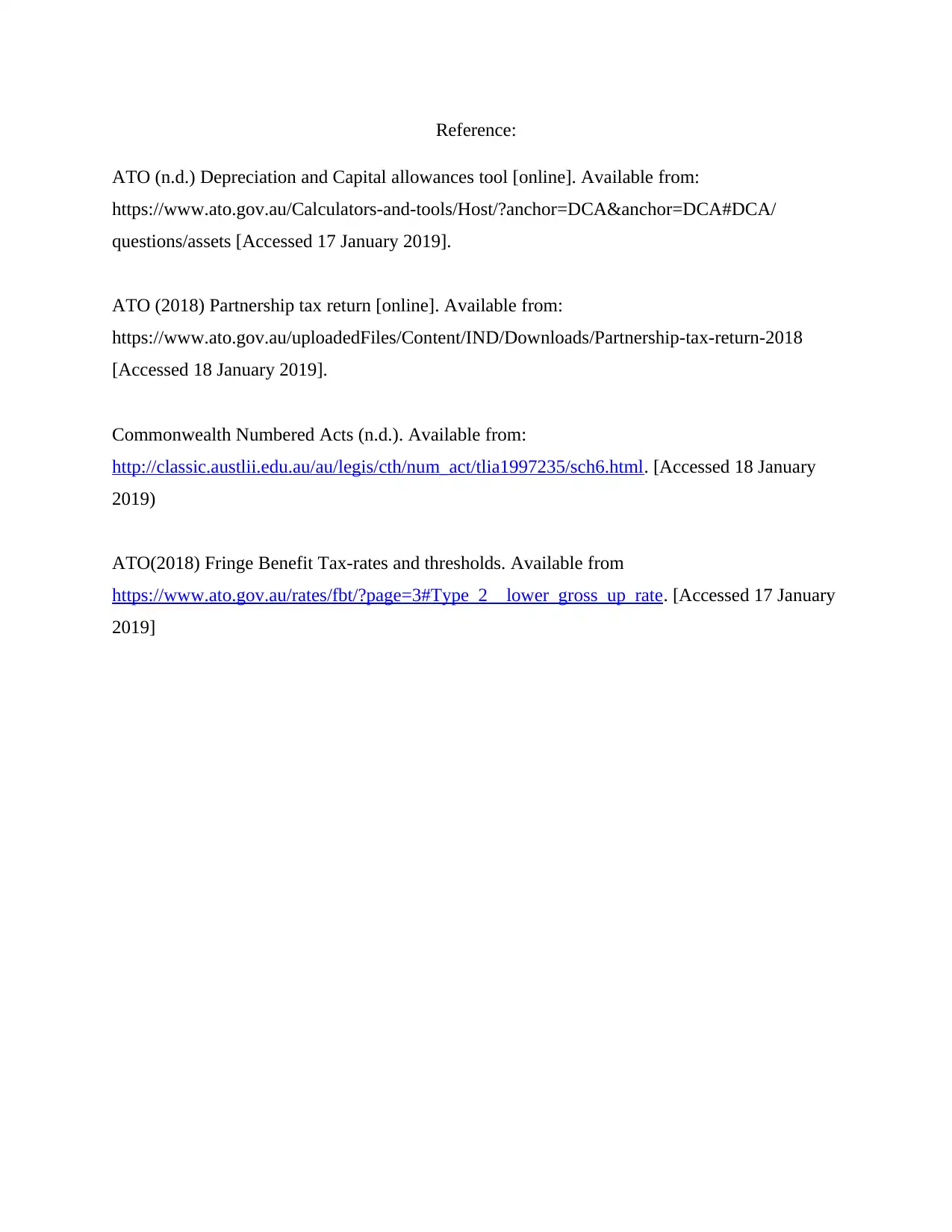
Reference:
ATO (n.d.) Depreciation and Capital allowances tool [online]. Available from:
https://www.ato.gov.au/Calculators-and-tools/Host/?anchor=DCA&anchor=DCA#DCA/
questions/assets [Accessed 17 January 2019].
ATO (2018) Partnership tax return [online]. Available from:
https://www.ato.gov.au/uploadedFiles/Content/IND/Downloads/Partnership-tax-return-2018
[Accessed 18 January 2019].
Commonwealth Numbered Acts (n.d.). Available from:
http://classic.austlii.edu.au/au/legis/cth/num_act/tlia1997235/sch6.html. [Accessed 18 January
2019)
ATO(2018) Fringe Benefit Tax-rates and thresholds. Available from
https://www.ato.gov.au/rates/fbt/?page=3#Type_2__lower_gross_up_rate. [Accessed 17 January
2019]
ATO (n.d.) Depreciation and Capital allowances tool [online]. Available from:
https://www.ato.gov.au/Calculators-and-tools/Host/?anchor=DCA&anchor=DCA#DCA/
questions/assets [Accessed 17 January 2019].
ATO (2018) Partnership tax return [online]. Available from:
https://www.ato.gov.au/uploadedFiles/Content/IND/Downloads/Partnership-tax-return-2018
[Accessed 18 January 2019].
Commonwealth Numbered Acts (n.d.). Available from:
http://classic.austlii.edu.au/au/legis/cth/num_act/tlia1997235/sch6.html. [Accessed 18 January
2019)
ATO(2018) Fringe Benefit Tax-rates and thresholds. Available from
https://www.ato.gov.au/rates/fbt/?page=3#Type_2__lower_gross_up_rate. [Accessed 17 January
2019]
1 out of 7
Related Documents
Your All-in-One AI-Powered Toolkit for Academic Success.
+13062052269
info@desklib.com
Available 24*7 on WhatsApp / Email
![[object Object]](/_next/static/media/star-bottom.7253800d.svg)
Unlock your academic potential
© 2024 | Zucol Services PVT LTD | All rights reserved.





